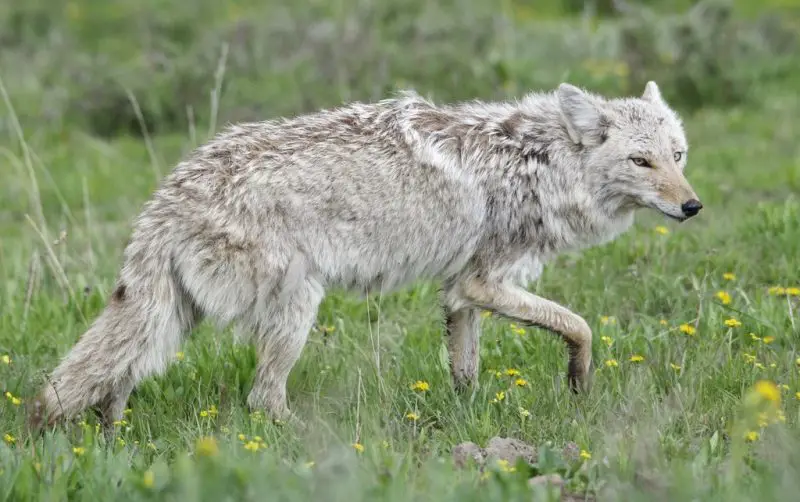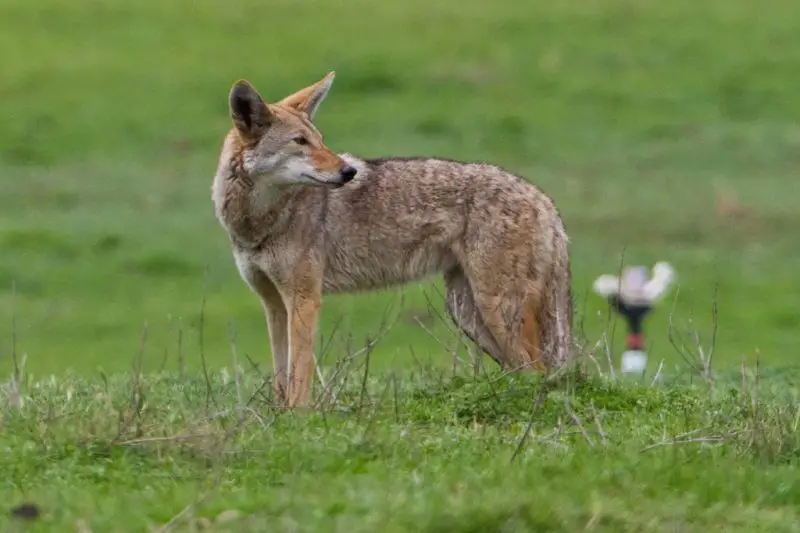Coyotes are some of the most adaptable mammals in North America, flourishing everywhere from the arid deserts of Southern California to the foggy redwood forests of the north. Known scientifically as Canis latrans, these intelligent predators have successfully adjusted to both wild and urban environments, often spotted near human settlements.
California, with its diverse geography, provides a perfect haven for several regional variations of coyotes. From the desert dwellers of the Mojave to the larger coastal coyotes near San Francisco, these animals display fascinating physical and behavioral differences shaped by their habitats.
In this article, we’ll explore the four main types of coyotes found in California — the Desert Coyote, Valley Coyote, Mountain Coyote, and Coastal Coyote. You’ll learn how to identify each one by their size, coat color, and where they’re most commonly seen across the Golden State.
Desert Coyote (Canis latrans ochropus)

Appearance and Identification
The Desert Coyote is the most common subspecies in the southern parts of California, especially across the Mojave and Colorado Deserts. It is smaller and leaner than its northern relatives, an adaptation to the extreme heat and limited food supply of arid landscapes. Adults usually weigh between 18–25 pounds, with a narrow face, large ears, and a shorter, thin tail.
Their fur is pale grayish-tan to light brown, often with a wash of yellow or cream along the flanks. This coloration helps them blend seamlessly with sandy desert terrains. Compared to the Mountain Coyote, their coat is shorter and less dense, which assists in staying cool under intense sun exposure.
Habitat and Behavior
Desert Coyotes thrive in open scrublands, rocky canyons, and dry washes, where they feed on small mammals, reptiles, and carrion. They are also known for their opportunistic feeding habits—raiding trash bins or hunting insects when larger prey is scarce.
At night, their haunting howls echo across the desert, serving both as territorial signals and group communication. Their activity peaks in the cooler hours of dawn and dusk to avoid the desert’s daytime heat.
Distribution in California
You can spot Desert Coyotes throughout San Bernardino County, Riverside County, and Imperial County, as well as parts of Death Valley National Park. Their adaptability also allows them to wander close to desert towns such as Palm Springs and Joshua Tree.
Valley Coyote (Canis latrans ochropus – Central Valley variant)

Appearance and Identification
The Valley Coyote, often considered a regional variation of the Desert Coyote, is widespread across California’s Central Valley. Slightly larger than desert types, these coyotes have softer grayish-brown coats with tinges of black and reddish hues around the muzzle and legs. They often weigh between 22–30 pounds, maintaining a slender yet muscular build suited for traversing open plains and farmlands.
Valley Coyotes exhibit sharp intelligence and remarkable adaptability. Their fur tends to be thicker in winter, reflecting the Valley’s seasonal climate changes. They are known to have bright yellow eyes and a bushier tail tipped with black.
Habitat and Behavior
These coyotes are frequently seen near agricultural areas, grasslands, and rural communities, where food sources are abundant. They hunt rabbits, ground squirrels, and rodents, but they are also notorious for raiding poultry farms or feeding on fallen fruits and crops.
Valley Coyotes have learned to coexist near humans, often scavenging roadkill or taking advantage of irrigation ditches for water. They’re excellent communicators, using barks and yips to maintain social contact within packs.
Distribution in California
This subspecies dominates the Central Valley region, stretching from Redding in the north to Bakersfield in the south. They are especially common near Sacramento, Fresno, and Modesto, where open farmland and suburban edges meet.
Mountain Coyote (Canis latrans lestes)

Appearance and Identification
The Mountain Coyote is larger and heavier than its desert and valley counterparts, weighing between 30–45 pounds. It has a thick, dense coat ranging from grayish-brown to silvery-gray, with darker saddle markings on its back. This luxurious fur not only provides insulation against cold mountain winters but also gives the animal a majestic appearance.
Its face is broad with smaller ears compared to the Desert Coyote, helping minimize heat loss. The tail is long, full, and bushy, often carried downward while running. The Mountain Coyote’s eyes are amber or gold, and its muzzle tends to be longer and sturdier.
Habitat and Behavior
Mountain Coyotes inhabit higher elevations, typically between 3,000–8,000 feet, across mountain ranges like the Sierra Nevada and the San Gabriel Mountains. They thrive in forested regions, alpine meadows, and foothill zones.
Their diet consists mainly of deer fawns, hares, marmots, and birds, but they will also scavenge carrion during harsh winters. Due to the rugged terrain, they tend to hunt alone or in small family groups rather than large packs. Their howls are deeper and slower, resonating through forest valleys at dusk.
Distribution in California
You can find Mountain Coyotes across Northern and Eastern California, especially in Yosemite National Park, Lake Tahoe, and the San Bernardino Mountains. Their thick coats and powerful builds make them well-suited to snow-covered environments.
Coastal Coyote (Canis latrans clepticus)

Appearance and Identification
The Coastal Coyote is a distinct subspecies found along California’s coastal regions, from Santa Barbara up to Mendocino County. It is slightly smaller than the Mountain Coyote but heavier than the Desert Coyote, averaging 25–35 pounds.
This subspecies has a reddish-brown to gray coat, often with dark streaks on the back and lighter underparts. Its fur tends to be sleek but slightly oily to resist damp conditions common in foggy coastal environments. Coastal Coyotes also have a sharper, narrower face and a noticeably bushy tail.
Habitat and Behavior
Living near beaches, coastal scrublands, and forest edges, these coyotes are known for their boldness and curiosity. They often adapt to suburban life, frequenting parks, golf courses, and even coastal cities like Los Angeles and San Diego.
Their diet is highly diverse, including fish, crabs, rodents, fruits, and human refuse. Coastal Coyotes are also skilled swimmers, occasionally foraging near tidal pools or river estuaries. They tend to be more social than inland types, with family groups often observed in coastal reserves.
Distribution in California
This type is primarily found along the Pacific Coast, especially in Malibu, Big Sur, and Point Reyes National Seashore. Some populations extend inland into the Coastal Range foothills, where they overlap slightly with Valley Coyotes.
How to Identify Coyotes in California
Size and Build
Coyotes in California generally range from 18 to 45 pounds, depending on subspecies and region. Desert Coyotes are the smallest, while Mountain Coyotes are the largest and most robust.
Coat Color
Coat color varies dramatically — from the pale sandy tones of desert dwellers to the dark gray and silvery hues of mountain populations. Coastal Coyotes often display reddish or russet tones, while Valley Coyotes fall somewhere in between.
Vocalization
All coyotes are known for their characteristic howls, yips, and barks, but tone and pitch may differ. Desert Coyotes produce shorter, higher-pitched calls, while Mountain Coyotes deliver slower, lower howls that carry farther in dense forests.
Tracks and Signs
Coyote tracks resemble those of a domestic dog but are narrower and more oval-shaped. Their scat often contains fur, bones, or seeds. Look for tracks along hiking trails, dry riverbeds, and dirt roads, especially during early morning hours.
Are Coyotes Dangerous in California?
Coyotes are generally not dangerous to humans, but they can pose a threat to pets and small livestock, especially in suburban areas. Encounters are most common in spring and summer when food demand increases for nursing mothers and growing pups.
Experts recommend never feeding coyotes, keeping pets leashed, and securing trash cans. If approached, make loud noises, wave your arms, or use motion-activated lights to discourage their presence. Despite rare conflicts, coyotes play a vital ecological role by controlling rodent populations and scavenging carcasses.
Conservation and Human Interaction
Coyotes are classified as “Least Concern” by the IUCN due to their wide distribution and high adaptability. In California, they have learned to coexist within cities, farmlands, and wilderness alike. Urban coyotes help maintain ecological balance even in metropolitan areas like Los Angeles, where they feed on rats and food waste.
However, habitat loss and vehicle collisions remain significant threats. Wildlife management programs in California emphasize non-lethal coexistence methods, focusing on education, deterrents, and research rather than eradication.
Conclusion
Coyotes are a remarkable symbol of California’s wildlife resilience. From the scorching deserts to fog-draped coasts, these intelligent canids have adapted to every corner of the state. Understanding the four main types — Desert, Valley, Mountain, and Coastal Coyotes — helps us appreciate their diversity and coexist more peacefully with them.
Each variation reflects a story of survival shaped by California’s rich ecological mosaic. Whether you spot one darting across a desert road or hear a distant howl near the redwoods, you’re witnessing an enduring part of nature’s balance — the ever-resourceful coyote.
FAQs About Coyotes in California
What kind of coyotes live in California?
California is home to four main types of coyotes: the Desert Coyote, Valley Coyote, Mountain Coyote, and Coastal Coyote. Each type has distinct physical and behavioral traits shaped by its environment. Desert Coyotes are small and sandy-colored, while Mountain Coyotes are large with thick gray coats. Coastal Coyotes are reddish-gray and often seen near beaches and suburbs.
Are coyotes common in California?
Yes. Coyotes are found in nearly every region of California — from urban Los Angeles neighborhoods to remote desert valleys and mountain forests. Their adaptability allows them to thrive in both natural and human-altered landscapes. They are especially common in Southern California, the Central Valley, and along the coastal ranges.
Are coyotes dangerous to humans?
Coyotes rarely pose a threat to humans. Most conflicts arise from feeding or attracting them unintentionally with garbage, pet food, or unsecured livestock. They can, however, pose risks to small pets, especially during pup-rearing season (spring to summer). To stay safe, avoid feeding coyotes, keep pets leashed, and make loud noises if a coyote approaches.
What do coyotes eat in California?
Coyotes are opportunistic omnivores, meaning they eat whatever is available. Their diet includes rodents, rabbits, reptiles, birds, fruits, insects, and carrion. In urban areas, they also scavenge pet food, trash, and even fallen fruit from gardens. This adaptability in diet has made them one of the most successful predators in North America.
Where do coyotes live in California?
Coyotes inhabit nearly all types of ecosystems across the state, including deserts, valleys, mountains, forests, and coastal areas. Desert Coyotes prefer arid scrublands like the Mojave, Mountain Coyotes live in the Sierra Nevada and San Bernardino ranges, while Coastal Coyotes dwell near beaches, cliffs, and urban parks along the Pacific Coast.
What time are coyotes most active?
Coyotes are primarily nocturnal and crepuscular, meaning they are most active during dawn and dusk. These times offer cooler temperatures and better hunting conditions. However, in suburban or rural areas, it’s not uncommon to see coyotes during the daytime, especially when searching for food or caring for young.
How big are coyotes in California?
The size of coyotes in California varies depending on the subspecies. Desert Coyotes typically weigh around 18–25 pounds, Valley Coyotes range from 22–30 pounds, Mountain Coyotes can reach up to 45 pounds, and Coastal Coyotes usually weigh 25–35 pounds. Males are generally larger than females.
How can you tell a coyote from a dog?
Coyotes can look similar to medium-sized dogs, but there are key differences. Coyotes have narrower snouts, larger pointed ears, longer legs, and bushier tails that they carry low while running. Their movements are also more graceful and deliberate compared to domestic dogs. In addition, their howls and yips are distinctive and often heard at night.
Are coyotes protected in California?
Coyotes are classified as non-game mammals in California, meaning they are not legally protected but are managed under state wildlife laws. While property owners can control problem coyotes under specific conditions, the California Department of Fish and Wildlife (CDFW) encourages non-lethal management methods, such as securing food sources and using deterrents.
What should you do if you see a coyote?
If you encounter a coyote, stay calm and do not run. Make yourself appear larger by waving your arms or jacket, shout loudly, and slowly back away. Never turn your back or approach a coyote, especially if pups are nearby. If a coyote appears aggressive or sick, contact local animal control or wildlife authorities immediately.
Do coyotes attack pets?
Yes, coyotes may attack small pets such as cats or small dogs if left unattended, especially at dawn or dusk. To protect your pets, keep them indoors at night, use motion-activated lights, and secure yards with tall fencing. In rural or suburban areas, always supervise outdoor pets.
How do coyotes communicate?
Coyotes communicate through howls, yips, growls, and barks. These vocalizations serve to locate family members, mark territory, and warn off rivals. A chorus of howls often gives the illusion of a large pack, but it’s typically only a few individuals calling together. Coyotes also use scent marking and body language for communication.
Why are coyotes important to California’s ecosystem?
Coyotes play a vital role as top mid-level predators in California’s ecosystems. They help regulate populations of rodents, rabbits, and other small mammals, which keeps the food web in balance. Their scavenging habits also aid in cleaning up carrion and reducing disease spread among wildlife populations.
Can you keep a coyote as a pet in California?
No, it is illegal to keep a coyote as a pet in California. Coyotes are wild animals that require specialized diets, large territories, and natural behaviors incompatible with domestic life. Attempting to domesticate or raise a coyote can result in unpredictable behavior and legal penalties.
Do coyotes mate for life?
Coyotes are monogamous animals, often mating for life. Pairs usually form during winter, and females give birth to 4–7 pups in spring. Both parents participate in raising and protecting the young until they disperse in autumn. This strong family structure contributes to the coyote’s survival success across California.
How long do coyotes live in California?
In the wild, coyotes typically live 6 to 10 years, though some can reach up to 14 years under favorable conditions. Urban coyotes often have shorter lifespans due to vehicle collisions, diseases, and human conflicts, while those in remote areas tend to live longer.
Why do coyotes howl at night?
Coyotes howl primarily to communicate with their pack or mark their territory. Nighttime is ideal because sound travels farther, making it easier for family members to locate each other. Contrary to popular belief, coyotes don’t howl “at the moon” — it’s simply their way of staying connected and defending their range.






